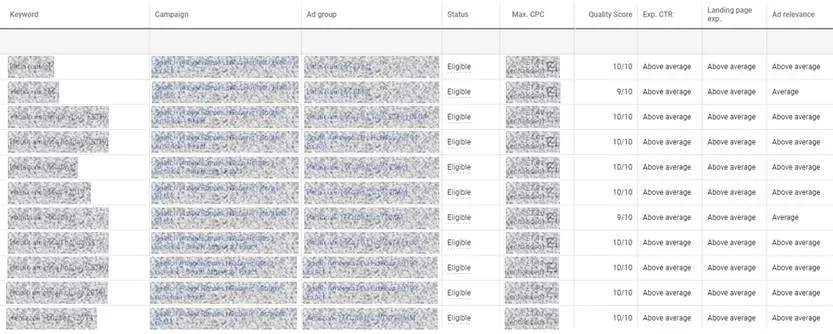Confused about your Quality Scores? If you’re running a Google Ads account, you’ve probably wondered about your Quality Score and why it changes from time to time.
There are a lot of factors that go into working out your Quality Score. The difference between a good and a bad score can have a direct impact on your budget and your bottom line.
In this guide, we will explain everything you need to know about your Google Ads Quality Score and how you can improve your ad campaigns.
What is Quality Score?
Here’s what Google says:
“Quality Score is an estimate of the quality of your ads, keywords and landing pages. Higher quality ads can lead to lower prices and better ad positions.
- You can see your Quality Score (reported on a 1-10 scale) and its components (expected click-through rate, ad relevance and landing page experience) in the “Keyword Analysis” field of your account.
- The more relevant your ads and landing pages are to the user, the more likely it is that you’ll see higher Quality Scores.
- Quality Score is an aggregated estimate of your overall performance in ad auctions, and is not used at auction time to determine Ad Rank.”
Your Google Ads Quality Score is a value given to a keyword that tells you how relevant Google thinks your keywords, ads and landing pages are.
Quality Score is ranked out of 10. High scores are good, while low scores are bad.
Why should I care about Quality Scores?
You should care about Quality Scores because better quality ads lead to lower costs per click (CPC) and higher positioned ads in Google.
This is because Google feels like your ads provide a better experience to their users. So, to improve their service, they will promote and reward high-quality ads.
Higher Quality Score = lower cost per click
Lower cost per click = lower cost per conversion
Lower cost per conversion = more money in your budget
All of this helps you reach your ideal target CPA
Don’t believe us? Check out our CPA calculator.
Ultimately, you should care about Quality Scores because Google does. If you’re using Google Ads, you’re playing in their sandpit. You have to play by their rules if you want to see a decent return on your ad investment.
What does a high Quality Score indicate?
A high-quality score indicates that your ads, keywords and landing pages are delivering high-value experiences to your visitors at every step. From initial search, through to click and conversion, ad campaigns with high Quality Scores are prized by Google.
In exchange, you get to enjoy lower CPC and more favourable ad positioning. You also have the satisfaction of knowing that your customer journey is high quality and delivers rewarding experiences.
How can I see my Quality Score?
You can set up your “Keywords view” of your Ad Campaigns to display your Quality Score. This will give you an easy, top-level view of your performance.
From this view, you can easily see whether you’re making positive or negative changes to your keywords Quality Score.

How to view Quality Score
- Click the Campaigns
- Select the Keywords
- Click the Columns drop-down menu in the toolbar above the statistics table
- Select Modify columns
- Select Quality Score
- To see the current Quality Score and its component statuses, choose any of the following to add to your statistics table:
- Qual. Score
- Landing Page Exper.
- Ad Relevance
- Exp. CTR
- To see past Quality Score and component stats, segment by day and choose any of the following to add to your statistics table:
- Qual. Score (hist.)
- Landing Page Exper. (hist.)
- Ad Relevance (hist.)
- Exp. CTR
- Click Apply
What factors affect Quality Score?
There are many factors that affect Quality Score. But the big three are relevance, user experience and expected click-through rate.
1. Ad relevance
Ad Relevance is the degree to which your ad relates to the keywords you’re targeting. Google Ads rates your relevance as above average, average or below average.
If your ad relevance is below average it will impact your Quality Score. Below average ad relevance may indicate that your keywords are either not specific enough or your ad group is too broad.
Top Tip!
Try narrowing down your keyword list by creating ad groups with more closely-knit keywords.
2. Landing Page Experience
Landing Page Experience is pretty much what it sounds like. It’s the same thing that your designers, SEOs and CRO experts talk about.
Landing Page Experience is all about giving the user a valuable and desired experience on-page, with a view to them performing converting actions you want them to perform. Google Ads quantifies these experiences in a way that other digital marketing tools don’t.
Landing Page Experience is measured on conversions, bounce rate, dwell time on page and other user signals. So, in addition to helping users convert, a good landing page experience is vital for your Quality Score.
This is where you can start to see how these elements all feed into each other. Better landing pages result in higher Quality Score and Ad Rank. Higher Quality Scores mean lower advertising costs.
Top Tip!
A/B testing can help you test different elements of your landing pages to see what works best.
3. Expected click-through rate (CTR)
Expected CTR measures the likelihood that your ads will be clicked when they are shown for a specific keyword. According to Google themselves, CTR alone is responsible for as much as 60% of your Quality Score. Just like Ad Relevance, CTR is judged as being above or below average.
Top Tip!
Boost CTR by making the most of your ad extensions.
Other factors that affect Quality Score include:
- Your ad’s CTR
- Geographic performance
- Performance per device
How to improve Quality Score
The best way to improve your Quality Score is to focus on the three core factors and improve each one. So, you’ll be focusing on improving ad relevance, CTR and on-page user experience.
Improving ad relevance
Low ad relevance means that your keywords aren’t matching search intent on your on-page content. Spend time doing in-depth keyword research to discover new, highly relevant keywords.
Don’t forget long-tail keywords! They can provide new opportunities that can contribute to the bulk of your overall traffic with highly relevant visitors.
Once you have your new keywords, it’s important to allocate them into precise, well-managed ad groups that can be carefully deployed into specific ad campaigns.
Boosting CTR
You can’t just fill your ad copy with keywords and proclaim it “good enough”. The best PPC ads use every character available to create concise, engaging ads that directly appeal to audiences in your ad groups. Make the best use of ad extensions and visually disruptive elements, such as numbers and symbols.
Your ad copy should, of course, include a call to action. Positive action words stir the reader into taking an action, while emotive language arouses curiosity. Combined, these elements make for powerful and attractive ads.
Ultimately, the best ad copy is written with a thorough understanding of the audience. Not only are you providing an offer you know they’ll want, but you’re also talking to them in the way they expect and providing incentives that mean the most to them.
Providing a better on-site experience
The first step in providing a high-quality on-site experience is meeting the expectations of the visitor. This means that the intent of your ad needs to match the content on your page.
To make sure your page delivers on the expectations of your ads, consider adding negative keywords to your campaigns. These will exclude irrelevant search terms that cause people to click on your ad by mistake and leave, which will affect your bounce rate.
So, if your ad copy is advertising “Cookies” and hungry searchers click on your ad expecting a tasty treat, they will be disappointed if your business writes website cookie policies.
Negative keywords can help with that sort of mistake, allowing you to know exactly what people expect when they land on your page. From there, simply follow the 6 secrets to the perfect PPC landing page:
-
Grab the user’s attention
-
Offer value
-
Display trust
-
Keep it simple
-
Offer one clear path to conversion
-
Test, refine and improve
Effective landing pages have low bounce rates, high dwell time and high conversion rates. They also contribute to high Quality Scores.
Improve your Quality Score with effective PPC management
Low Quality Scores are often the result of miscommunication between keywords, ad groups, ad copy, and landing page content. They provide a poor user experience by confusing and misleading visitors. In addition to experiencing fewer conversions, your ad budgets will suffer too, as CPC costs increase.
A high Quality Score comes naturally when a Google Ads account is considerately and intelligently managed. You need to make sure that language is consistent from keyword groups through to ads, then on to on-page content, creating a unified, seamless experience.
As with most things controlled by Google, there is never a definitive answer to improving your PPC performance. But what we do know is that considering the relevance of your ads in relation to every aspect of the digital marketing sales funnel will help produce better results.
We understand it takes both time and effort to effectively manage a PPC campaign. That’s why we offer comprehensive PPC management as part of our digital marketing service. If you want to make the most of your paid search budgets, speak to us today and see how we can help.






